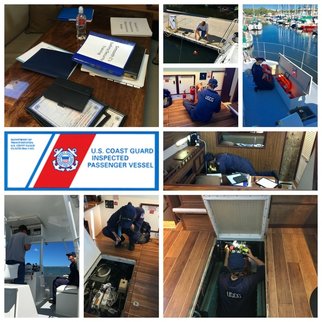
During a USCG onboard inspection, the inspector checks all vessel logs, which include safety/training, maintenance, emergency procedures, cruise/radio logs, charts, and official documents. Additionally, they verify all operators licenses, permits, first aid certifications, and compliance with an active drug consortium. The inspection also checks all PFD/life jackets/devices, fire extinguishers/fire suppression systems, bilges, thru-hull fittings, engines, generators, fuel tanks, waste systems, radio/PA, required safety lights, system alarms, and tests emergency shut-off and fire procedures.
During the Man Overboard Rescue drill, a life jacket is thrown overboard to simulate a passenger falling off the vessel. The captain and mate must work together to safely retrieve the victim and coordinate further care. Knowing what to do when a passenger goes overboard may be the difference between life and death. After calling "Man Overboard" the mate must shout the position and distance of the victim, relative to the vessel, and request that the Coast Guard be notified. The mate then dons a PFD and tethers himself to the vessel in order to retrieve the victim. Depending on the severity of the injury, the mate will either stay with the victim on the swim platform or bring the victim up on the deck for continued care.
The annual onboard inspection by the USCG for a vessel our size usually takes 2-3 hours. These inspections are much different than the CG Auxiliary vessel checks that recreational and charter vessels limited to 6 passengers undergo. As a reminder, any vessel carrying more than 6 passengers for hire MUST have a COI (Certificate of Inspection). Learn more: USCG Charter Passenger for Hire and Charter Vessel Operations >


 RSS Feed
RSS Feed